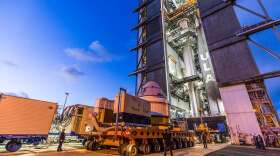Even in orbit, Starliner faces more delays
Boeing’s Starliner has had multiple issues since launching earlier this month including faulty thrusters and helium leaks. The crew’s new landing date has been pushed back to at least next week, much longer than the initial eight-day stay.
Laura Forczyk, a space industry analyst and founder of the consulting firm Astralytica, said no matter what, the crew will have a way back to our home planet.
“If there is something if they decide that they cannot use that capsule to return the astronauts back, they're going to make adjustments,” Forczyk said. “Again, they've got two additional vehicle types that they can come back on: SpaceX and Soyuz. And that is why we have this dissimilar redundancy. This is exactly why NASA chose two service providers for the Commercial Crew Program, SpaceX and Boeing, because if one ends up having issues, the astronauts can use another one.
Although there are backup solutions, Boeing and NASA are confident that issues will be resolved, and that the vehicle is safe to return the crew.
Forczyk said while it is possible these issues could have been avoided; space travel can be a risky business.
“When it comes to spaceflight, nothing is ever 100% safe,” Forczyk said. “And so what they did was look to see what the data told them. Is this crucial? Is this something that we can live with? And is it within tolerances. And when they launched, they decided that yes, this helium leak that they detected was within tolerance, we can launch and everything's going to be okay, because nothing is going to be a hundred percent.”
While it can be scary, Barry “Butch” Wilmore and Suni Williams stated in an exchange with NASA administrator Bill Nelson that they are glad to have the extra time in space. Forczyk said it is a great thing that Boeing and NASA chose two veteran astronauts for this mission.
“They are well versed in how to operate on Space Station, and they've got job to do” Forczyk said. “So, they're the ones who are up there being the eyes and ears and testers for the engineers on the ground. So not only are they working on Starliner in particular, but they're also doing their own work… And there's a reason why they put veteran astronauts on this mission on this mission is because they're the ones who don't need that adjustment period so much to adjust to living and working in space, they can really get the job done.”
Drilling on Mars
From solar storms to new discoveries, the Mars Rovers Curiosity and Perseverance have been working tirelessly to uncover more history that lay on the surface of Mars -- and beneath it.
Amy Williams, a member of the rovers’ science teams and astrobiologist at the University of Florida said the work that these rovers have done on Mars is remarkable. Before Curiosity, Williams said no other planet has been able to be drilled on.
Now, Curiosity is exploring a new area on Mars where water used to flow freely.

“With curiosity, we are climbing up the Gediz Vallis Channel and we've actually just gotten to a place that we call White Bark Pass,” Williams said. “And this looks like it's going to be our next drill location we're at kind of the right place where we try to have equal cadences of when we stop to drill and ingest sample and do analyses with our internal instruments.”
By drilling and studying beneath the surface of Mars, Williams said scientists can compare our planet with Mars and maybe answer how our solar system was created.
“You can really make a lot of interpretations about how water was flowing, how much was there, all these really neat interpretations you can make about ancient processes,” Williams said. “So, what's really cool when you get to river channels, just like on Earth, they cut down through the rocks. And you get these really amazing exposures across sections of the rock. So, things that you may not have had the opportunity to see if you're just driving across these rocks moving up in stratigraphy or up through the layers and so that's really cool.”







